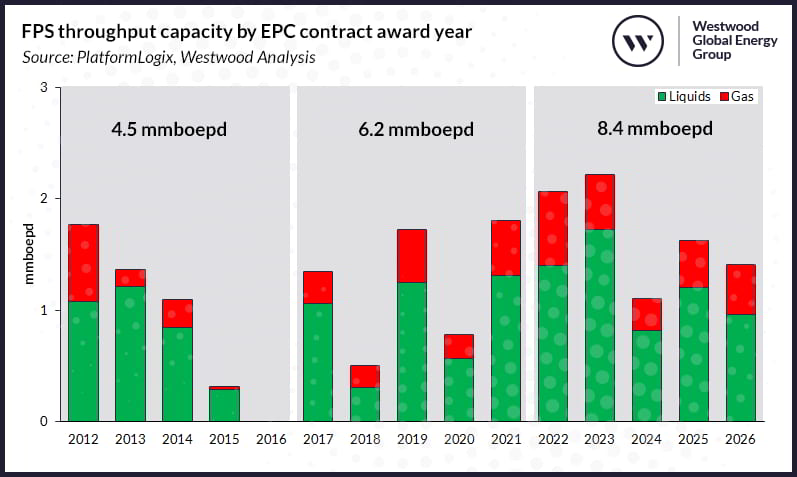(OET) Westwood Global Energy, an energy market research and consultancy firm, has outlined that 2022 will have the highest floating production system (FPS) throughput capacity sanctioned since 2010, despite major project delays caused by multiple factors, including the supply chain inflationary pressure, which remains a concern in the future as well.
Within its review of the FPS market, Westwood recently revealed that some exploration and production (E&P) companies have been “bold with investments” in the development of their oil and gas reserves, with a total of 1.9 mmboepd – 1.3 mmbpd of oil and 3.8 bcfd of gas – FPS throughput capacity sanctioned year to date (YTD). As this represents a 7 per cent increase from 2021, the energy market research provider anticipates an additional 180 kboepd of FPS throughput capacity to be sanctioned before year-end.
Furthermore, a total of 13 FPS units have been sanctioned so far this year, with an estimated engineering, procurement and construction (EPC) value of $15 billion, a 9 per cent increase year-on-year. Ten of these units were floating production, storage and offloading (FPSO) units, three were floating production semi-submersible (FPSS) platforms, whilst no spars nor tension leg platforms (TLPs) were awarded, highlighted Westwood.
Despite an increase in total FPS EPC contract award value and throughput capacity sanctioned this year compared to 2021, the inflationary cost environment and global supply chain uncertainties have resulted in some E&Ps opting to delay EPC contract awards for major FPS projects, which were previously planned for 2022. Previously, Westwood anticipated 25 FPS units, with an EPC value of $19 billion will be sanctioned this year.
However, delays and changes in development concepts to projects such as Equinor’s Wisting development in Norway, Shell’s Gato do Mato in Brazil, Shell’s Linnorm in Norway and Santos’ Dorado project in Australia resulted in a 14 per cent downward revision. As a result, the 2022 FPS EPC award value is now anticipated to close at approximately $16.4 billion, driven by 15 units, out of which eight are newbuilds, two are conversions and five are upgrades/redeployments.

Moreover, Westwood underscored that the EPC contract value for Petrobras’ P-80, P-82 and P-83 were higher than initially forecasted, reducing the impact of delayed projects on the 2022 EPC value. The energy market research firm anticipates an upgrade to Cenovus Energy’s Sea Rose FPSO unit, and an EPC contract for CNOOC’s Deepwater 2 FPSS could still be sanctioned before the end of 2022.
How things stand for 2023
Regarding its outlook for 2023, Westwood estimates FPS throughput capacity to be sanctioned to total 2.2 mmboepd, with an EPC award value of $16 billion. Driven predominantly by activities in Latin America and West Africa, the major EPC awards anticipated in 2023 include Petrobras’ P-81, P-84 and P-85 FPSOs, as well as Equinor’s Pao de Acucar unit offshore Brazil.
While Modec recently signed the front-end engineering and design (FEED) contract in Guyana for the fifth Stabroek FPSO unit to be deployed on ExxonMobil’s Uaru, the EPCI contract award anticipated in 2023 is subject to governmental approvals of the field development plan and a final investment decision by the U.S. energy giant.
Meanwhile, Westwood pointed out that other FPS units to watch in 2023 include Azule Energy’s Agogo FPSO in Angola, TotalEnergies’ Cameia FPSO also in Angola, Eni’s Baleine FPSO in Ivory Coast and Woodside Energy’s Trion FPSS in Mexico. Citing the need to optimise the development and execution plan, cost, and development schedule, Woodside delayed the FID from 2022 and expects bid submission for the Trion unit in 1Q 2023.
Rising costs continue to plaque projects
Westwood further underlined that cost deflation, simplification and standardisation have seen the EPC cost of FPSO units fall dramatically over the past five years, averaging $7,950/boepd of throughput capacity. This is a 38 per cent discount compared to the highs of $12,795/boepd observed over the 2013/14 period.
However, an increase in the volume of active EPC tenders and an uptick in industry cost have resulted in average 2022 EPC costs of $9,310/boepd, based on Westwood’s data. This represents a 17 per cent increase over the 2017-2021 period and a 32 per cent increase compared to activities in 2020 during the peak of the Covid-19 pandemic.
Bearing in mind five-year contracting periods between 2012 and 2026, the energy market research player emphasised that the forecast for the FPS throughput capacity to be sanctioned over the 2022-2026 period represents a 36 per cent increase compared to the preceding five-year period and an 87 per cent growth on the 2012-2016 period. In spite of this growth, rising costs are causing significant delays to major projects, says Westwood.
Additionally, concerns over shipyard capacity remain, as China’s zero-Covid policy could exacerbate supply chain constraints, following uncertainties created due to the war in Ukraine. If an uptick in industry costs continues, previously delayed projects such as Equinor’s Rosebank in the UK and Bay Du Nord development in Canada, Shell’s Bonga SW in Nigeria and TotalEnergies’ Block 58 development could experience further delays.
Westwood concludes that if these projects are postponed, this would impact the total FPS throughput capacity to be sanctioned over the forecasted period.



Leave a Reply